

The Long Game and Its Contradictions. (This essay is also available in Portugese and Spanish) The People’s Republic has overcome feudal corruption and colonial oppression, emerged from “100 years of humiliation”, rebuilt from rubble, repeatedly foiled imperialist attempts at destabilisation and sabotage, to remain 100% independent, and is today developing socialist power on the world stage.

The path chosen by the Communist Party is now, as it has been since 1949, guided by Marxism Leninism, but not a dogmatic interpretation. Socialism with Chinese Characteristics is shaped by the concrete geopolitical realities today, and is adapting to the global material conditions of the 21st Century. The following is a bird’s-eye-view outline of China’s concrete path of national rejuvenation and international world historic decolonisation, paving the road toward global communisation. Nationally, the communist party aims to build a harmonious, prosperous, sustainable, and robust home base on which international engagements will rest. China Ballistic Missile Test: China-U.S. Military Conflict. Xinhua News AgencyGetty Images China fired two anti-ship ballistic missiles into the South China Sea.The missiles are designed to attack enemy warships, particularly aircraft carriers.The test was in response to recent U.S.
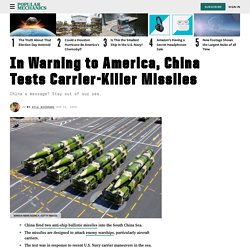
Navy carrier maneuvers in the sea. China launched two ballistic missiles from the mainland into the South China Sea on Wednesday. The rare double test was almost certainly a warning to the U.S. Navy, which has sent several aircraft carriers into the sea on exercises this year. Dive deeper. ➡ Read , starting now. Collision Course: China claims F-22 and Rafale have “No Chance” against the J-20. Chinese state-run media is challenging the United States and India, claiming that the J-20 “stealth fighter” is more than a match for American F-22 Raptor and India’s newly-acquired Rafale.
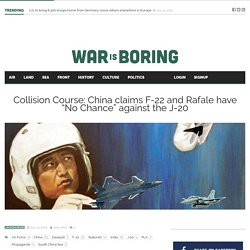
Two articles regarding the J-20’s capabilities -posted on the same day- were featured in the South China Morning Post and the Global Times, media outlets that ultimately fall under control of the Chinese Communist Party. While articles praising military hardware are not uncommon for any nation, the two articles regarding the Chengdu J-20 were rather pointed in their own ways.
“America’s F-22 stealth fighter may be limited in Asia-Pacific conditions, China’s J-20 designer says,” read the title of the South China Morning Post article. The SCMP article cited a claim -reportedly made by J-20 designer Yang Wei- that the F-22 was designed to fight in Europe and that it would potentially struggle against “homegrown” aircraft in the Asian-Pacific combat environment. Lt. The incident turned Lt. Lt. ‘Completely out of control’: China says ‘US epidemic’ has become a threat to rest of the world. A Chinese state-controlled newspaper has blamed the Trump administration’s mishandling of the COVID-19 pandemic to cause the spread of the virus to go “completely out of control.”
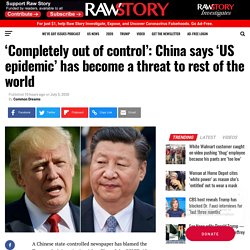
Describing the disease as a “U.S. epidemic”, the paper warned that the administration’s failure poses a threat to the rest of the world. “Lies are dominating US society’s recognition of the epidemic,” the Global Times wrote. The dramatic spike in the numbers of US COVID-19 infections continues this weekend. New coronavirus cases in Florida on Sunday exceeded 10,000 in a day for the third time in the past week, after the state posted a record high of 11,458 the previous day. China's beachhead in Europe - Axios. Admiral warns U.S. that China's navy could sink two aircraft carriers and kill 10,000 sailors. 'We'll see how frightened America is': Admiral warns U.S. that China's navy could sink two aircraft carriers and kill 10,000 sailors if it stands in way of Beijing's goals in South China Sea Rear Admiral Luo Yuan is an officer in China's People's Liberation Army NavyOn December 20, he appeared at a summit in the city of ShenzhenLuo said China is capable of sinking two American aircraft carriers in PacificChina and U.S. have ongoing disputes over territorial claims in South China SeaChina also seeks to unify Taiwan with the mainland, even if it means use of force By Ariel Zilber For Dailymail.com and Reuters Published: 20:21 EST, 1 January 2019 | Updated: 23:00 EST, 1 January 2019 A Chinese Admiral said recently that his country's military is capable of sinking American aircraft carriers in the East and South China Seas.
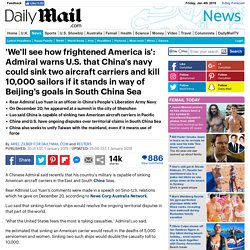
Rear Admiral Luo Yuan's comments were made in a speech on Sino-U.S. relations which he gave on December 20, according to News Corp Australia Network. Loaded: 0% Progress: 0% China’s New Submarine Nuke Could Hit America. The Chinese navy has tested a new submarine-launched ballistic missile, one that could eventually allow Chinese ballistic-missile boats, or “boomers,” to threaten the continental United States from waters that are close to China’s shores, and thus safer for the boomers.

The People’s Liberation Army Navy tested the JL-3 missile on Nov. 24, 2018, The Diplomat reported, citing unnamed U.S. government sources. “Modernization of China’s submarine force remains a high priority for the PLAN,” the U.S. Defense Department explained in its 2018 report on Chinese military capabilities. China’s New Nuke Subs Might Boost World Stability. China for decades has struggled to develop nuclear ballistic-missile submarines.

The country finally might be on the cusp of deploying reliable boomers. An effective Chinese ballistic-missile submarine fleet over the long term could have a stabilizing influence on the world’s nuclear balance. But in the short term, it might heighten tensions. Especially if Beijing lets popular fervor drive its build-up.
China Could Announce a ‘Total Exclusion Zone’ at Any Time. With all the coverage of North Korea over the last year, it’s easy to forget about the other major Cold War legacy that still haunts the East Asian region.

Even as the ideologically-infused fratricidal war among Koreans never really ended, the same can be said, to some extent, of the Chinese Civil War. Indeed, few can recall these days that the fates of Korea and Taiwan were intrinsically linked. Robot War in the South China Sea? As technology advances relentlessly, the real prospect of robot wars is apparently almost upon us.
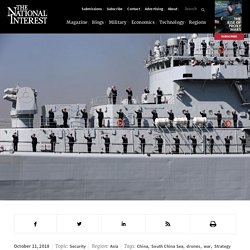
The 2015 book Ghost Fleet , written by Peter Singer and August Cole, lays out a vision of a future war between China and the United States, and the role of artificial intelligence (AI) in that hypothetical military conflict is not small. Drones of various types not only carry out surveillance in this novel but also play crucial roles in communications, logistics, as well as in high-intensity combat. In one memorable vignette, two American unmanned surface vehicles “following an algorithm developed from research done on the way sand tiger sharks cooperated in their hunting” successfully prosecute a Chinese nuclear submarine.
China’s Flawed Naval Fighter. China is developing a new carrier-based fighter aircraft to succeed the Shenyang J-15 Flying Shark .

The J-15—which is an unlicensed Chinese development based on a T-10K-3 prototype of the Russian Su-33 Flanker-D—has proven to be a disappointment in service with the People’s Liberation Army Navy. The navalized Chinese Flanker derivative has suffered a number of high-profile crashes due to technical issues with the aircraft’s engines and flight control system. The J-15’s problems are apparently serious enough that Beijing is embarking on the development of a new carrier-based aircraft that would take the J-15’s place in China’s nascent carrier air wings.
A “new carrier-based fighter to replace the J-15” is being developed, Lt. Gen. Chinese naval analysts have suggested that Beijing might develop a naval variant of the FC-31 Gyrfalcon, which is a “privately-funded” development of the state-owned Shenyang Aircraft Corporation. Above and at top — Chinese J-15 fighter planes. Laser Attacks Against U.S. Forces Spread to the Pacific. China’s Fourth Industrial Revolution: Artificial Intelligence. China’s Americanized Military. China Has A Breakthrough in Spy-Proof Quantum Communications. By sending quantum information several kilometers, the researchers took a big step toward the future of information security. A team of Chinese researchers say they have completed the first long-distance quantum secure direct communication, a critical step toward sending messages that are truly safe from eavesdropping. The information traveled 2.7 kilometers along a quantum channel, the team said in a paper that was peer-reviewed by China’s Science Bulletin journal and placed online Oct. 22.
Here’s why that matters: The feat, if verified, marks a critical step forward in the pursuit of communication that does not require end-to-end encryption and cannot be secretly intercepted by a third party. Today’s best encryption standards are nearly impossible to crack, but “nearly secure” is not “secure.” With enough computing power, they can be broken, just as Alan Turing’s Automatic Computing Engine penetrated Nazi Germany’s Enigma ciphers. Subscribe Receive daily email updates: Economist. Thinking the unthinkable in China: Abandoning North Korea.
© Provided by AFP China is under pressure to indicate growing calls to overhaul its relationship with the North, a longterm ally that it defended during the 1950-53 Korean War and has a mutual defence pact with. North Korea's nuclear antics have rattled its alliance with China to the point that Beijing is allowing the previously unthinkable to be discussed: Is it time to prepare for the renegade regime's collapse?
While China's official goal is to bring Washington and Pyongyang to the negotiating table, it is also permitting once taboo debate on contingencies in case war breaks out in the isolated nation across its northeast border. Observers say the public debate might be a tactic to try and coerce Pyongyang into cooling its weapons programme, with its nuclear and missile tests visibly angering Beijing, which has backed tough new United Nations sanctions on the country. "When war becomes a real possibility, China must be prepared. Why China Could Invade North Korea.
Over the past few months, tensions between the United States and North Korea have increased, with Kim Jung-un testing a possible hydrogen bomb on September 3 and the United Nations Security Council voting to implement further sanctions shortly after. Writers have discussed American policy towards China, the possibility of a deal with North Korea, and the need to avoid backing Kim into a corner. However, China’s perspective and the genuine possibility of a limited or complete Chinese intervention into North Korea, has received less coverage.
China might be compelled to act militarily if North Korea was attacked or collapsed on its own. Doing so would protect Beijing’s objectives of securing the border, preventing U.S. forces from nearing the Yalu River, and thwarting the emergence of a united, U.S. -allied democratic Korean state. Is This the Future of Chinese Submarine Power? Between major decisions on a new deployment to Afghanistan and a wholly new Persian Gulf crisis, not to mention the boiling crises in Syria and North Korea, Washington strategists can be forgiven for putting China’s naval buildup on the back burner. As Beijing fills the “near seas”—and now the “far seas”—with new frigates, destroyers and aircraft carriers, the orientation and larger strategy guiding its future submarine force remains an open question that this column has tried to focus on.
Moreover, the tendency of Washington analysts has been, rather predictably, to exaggerate the potential threat posed by China’s naval buildup; this columnist has repeatedly argued against that tendency. Objective assessments of China’s rapid naval modernization must be based on the best possible information regarding the Chinese Navy’s objectives and future plans. Yet before broaching these points, one should stop and sincerely congratulate the Chinese Navy for so openly discussing such issues.
Why China Will Never Put America First. Supporters of Taiwan have experienced both elation and dejection in recent months as President Donald Trump first seemed prepared to embrace the democratic island-nation only to turn around and instead engage in a romance with Chinese president Xi Jinping. The initial optimism resulted in large part from Trump’s campaign rhetoric, which promised a much more rigid line on China and an end to President Obama’s supposedly “weak” way of dealing with the authoritarians in Beijing on issues from currency manipulation to territorial expansion, human rights to cyber espionage.
For those who regard geopolitics as a zero-sum game between states, this stance held the promise of creating more space and opportunities for Taiwan. That enthusiasm was reinforced soon after Trump’s election in November. Some observers saw those early developments as signs of a paradigm shift in Washington, DC and a break from the establishment’s way of conducting policy. And that is exactly what happened. How Good Is China's New J-20 Stealth Fighter? Here’s How China Will Test Trump With North Korean Nukes. China is demanding South Korea not defend itself from North Korean missiles and nuclear weapons, which Beijing has helped Pyongyang develop.
Donald Trump, on his first day in office, is facing an impeachment crisis. It’s not targeting him, but it affects his presidency deeply by further straining testy relations with Beijing. On Monday, South Korea’s Defense Ministry announced a delay in the acquisition of land for the Terminal High Altitude Area Defense system, designed to shoot down incoming missiles. The timetable for this preliminary step “may be pushed back a bit,” said ministry spokesman Moon Sang-gyun.
Last July, South Korea’s President Park Geun-hye, after months of deliberation and over the strenuous objections of China, agreed to deploy THAAD, as the Lockheed Martin system is known, to defend against the threat of North Korean missiles that could carry nuclear warheads. Mao: Monster or Model? China builds artificial island in middle of Pearl Harbor.
HONOLULU — China has claimed a key new territory in its efforts to expand its reach in the Pacific region this week, building an artificial island inside Pearl Harbor, Hawaii. China to send nuclear-armed submarines into Pacific amid tensions with US. The Chinese military is poised to send submarines armed with nuclear missiles into the Pacific Ocean for the first time, arguing that new US weapons systems have so undermined Beijing’s existing deterrent force that it has been left with no alternative. China's Newest Military Recruitment Video Is Ridiculously Intense. These Vintage Propaganda Posters Show A Past China Wants To Ignore. The Chinese Submarine Threat. There has been extensive debate in recent years about modern Chinese anti-access/area-denial (A2/AD) systems rendering the aircraft carriers of the United States Navy (USN) highly vulnerable if Beijing and Washington were to clash in the western Pacific.
The American empire is over: Afghanistan, China and our new bystander status. Call it an irony, if you will, but as the Obama administration struggles to slow down or halt its scheduled withdrawal from Afghanistan, newly elected Afghan President Ashraf Ghani is performing a withdrawal operation of his own. He seems to be in the process of trying to sideline the country’s major patron of the last 13 years — and as happened in Iraq after the American invasion and occupation there, Chinese resource companies are again picking up the pieces.
In the nineteenth century, Afghanistan was the focus of “the Great Game” between the imperial powers of that era, Britain and Czarist Russia, and so it is again. China’s Alternative Diplomacy. Chinese president Xi Jinping has certainly kept China experts busy since he came to power in 2012. Xi has made major changes to Chinese policies, domestic and foreign. These policies have been quite different from those of his predecessors, keeping China scholars occupied explaining their meaning and implications. Religious sects: No-cult zone. A Prosperous China vs An Imperial US. If China's Airspace Grab Turns Violent, Here's How the Dogfight Could Go Down. China outsmarted US in Snowden affair, experts say.
Can China's Top Guns Fly? - By John Garnaut. Is This China's New Design for a Stealth Bomber? - An FP Slideshow. Pic of the day: Close up of China's J-31 stealth fighter. The World’s Largest Landing Craft Air Cushion(LCAC) Vehicle: China’s Amphibious Game Changer? Pentagon: The Chinese stole our newest weapons. China War Games: Army To Conduct Its First Digital Technology Military Exercise. Spy Sat Calibrators? King-Sized Jokes? China's Colossal Structures Confound. Ex-CIA analyst spots mysterious Chinese grids via Google Earth. National Socialism with Chinese Characteristics - By John Garnaut. China's newest stealth fighter flies. Pics of the week: Flight ops aboard China's aircraft carrier. The Empire Trapped. China in Revolt. Inside China: Missile defense conspiracy?